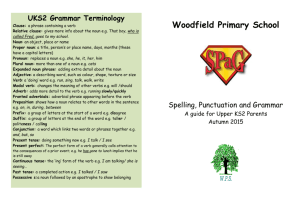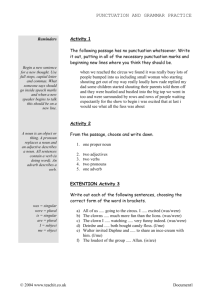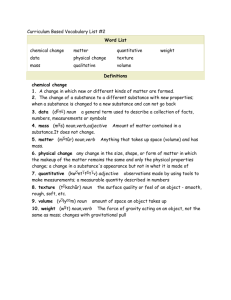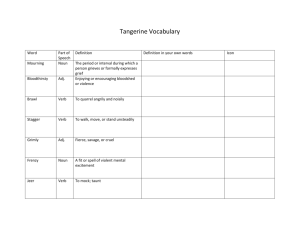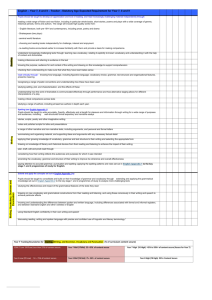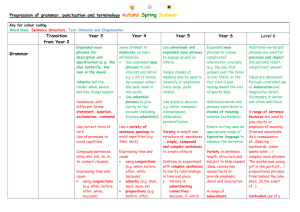Lower Key Stage 2 - SPaG - Woodfield Primary School
advertisement
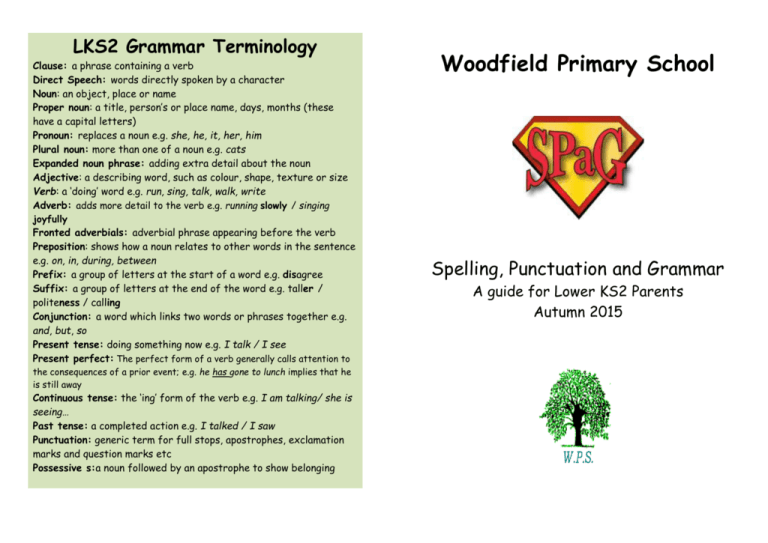
LKS2 Grammar Terminology Clause: a phrase containing a verb Direct Speech: words directly spoken by a character Noun: an object, place or name Proper noun: a title, person’s or place name, days, months (these have a capital letters) Pronoun: replaces a noun e.g. she, he, it, her, him Plural noun: more than one of a noun e.g. cats Expanded noun phrase: adding extra detail about the noun Adjective: a describing word, such as colour, shape, texture or size Verb: a ‘doing’ word e.g. run, sing, talk, walk, write Adverb: adds more detail to the verb e.g. running slowly / singing joyfully Fronted adverbials: adverbial phrase appearing before the verb Preposition: shows how a noun relates to other words in the sentence e.g. on, in, during, between Prefix: a group of letters at the start of a word e.g. disagree Suffix: a group of letters at the end of the word e.g. taller / politeness / calling Conjunction: a word which links two words or phrases together e.g. and, but, so Present tense: doing something now e.g. I talk / I see Present perfect: The perfect form of a verb generally calls attention to the consequences of a prior event; e.g. he has gone to lunch implies that he is still away Continuous tense: the ‘ing’ form of the verb e.g. I am talking/ she is seeing… Past tense: a completed action e.g. I talked / I saw Punctuation: generic term for full stops, apostrophes, exclamation marks and question marks etc Possessive s:a noun followed by an apostrophe to show belonging Woodfield Primary School Spelling, Punctuation and Grammar A guide for Lower KS2 Parents Autumn 2015 Dear Parents, Spelling, Punctuation and Grammar (SPaG) is now tested nationally in Year Two and in Year Six. At the end of each key stage, all children will be assessed on their ability to recall their knowledge and understanding in these areas so it is vital that we work together to prepare them for this. Quality teaching of SPaG in school and your support with the extension tasks set as homework, will give your child the best possible chance of success. For your child to do well in the SPaG tests, they don’t just have to be good at writing; they also need a technical understanding of how the English language works, including the correct grammatical terminology appropriate to their year group. We understand that supporting your child with learning SPaG can be challenging so we hope you will find this reference and glossary helpful and keep it to help you support your child with their learning. What’s changed in the new curriculum? The revised National Curriculum for English places a much stronger emphasis on vocabulary development, grammar, punctuation and spelling. Expectations have been raised in each year group with many aspects having to be taught at least a year earlier than in the previous curriculum. *Please note that children are expected to be secure in the previous year’s objectives as well as their own. New curriculum expectations New curriculum in Year 3 • Formation of nouns using a range of prefixes e.g. super–, anti–, auto– • Use of the determiners a or an according to the next word • Word families based on common words, showing how words are related in form and meaning e.g. solve, solution, solver, dissolve, insoluble • Expressing time, place and cause using conjunctions e.g. when, adverbs e.g. soon or prepositions e.g. before • Introduction to paragraphs, headings and sub-headings to aid presentation • Use of the present perfect form of verbs instead of the simple past e.g. He has gone out to play contrasted with He went out to play • Inverted commas to punctuate direct speech expectations in Year 4 • Plural and possessive –s • Standard English forms for verb inflections instead of local spoken forms e.g. we were instead of we was • Noun phrases expanded by the addition of modifying adjectives, nouns and prepositional phrases e.g. the teacher expanded to: the strict maths teacher with curly hair • Fronted adverbials e.g. Later that day, I heard the bad news. • Use of inverted commas and other punctuation to indicate direct speech • Apostrophes to mark plural possession e.g. the girl’s name versus the girls’ name • Use of commas after fronted adverbials

